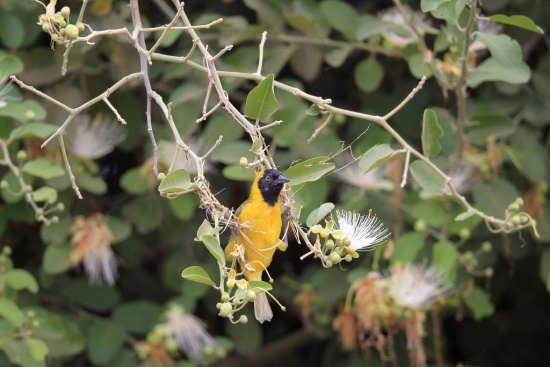(id) |
(Picture of male not on nest. Imp sizes. References updated) |
||
| Line 1: | Line 1: | ||
| − | [[Image: | + | [[Image:C83C5806.JPG|thumb|550px|right|Male<br /> Photo by {{user|Peter+Merritt|Peter Merritt}}<br /> [[Africa]], August 2013]] |
;[[:Category:Ploceus|Ploceus]] intermedius | ;[[:Category:Ploceus|Ploceus]] intermedius | ||
==Identification== | ==Identification== | ||
| − | Length 13-14 cm | + | Length 13-14 cm (5-5½ in)<br /> |
'''Adult male''': A pale-eyed masked weaver; the black mask extends onto the front half of the crown, and has a notch above the eye. Male has a black bill.<br /> | '''Adult male''': A pale-eyed masked weaver; the black mask extends onto the front half of the crown, and has a notch above the eye. Male has a black bill.<br /> | ||
'''Adult female''' has a pale pinkish-grey bill. <br /> | '''Adult female''' has a pale pinkish-grey bill. <br /> | ||
All adults have the greyish legs, but very young '''juveniles''' can have pink legs. Juveniles in addition have dark eyes | All adults have the greyish legs, but very young '''juveniles''' can have pink legs. Juveniles in addition have dark eyes | ||
| + | [[Image:Lesser_Masked_Weaver_female_by_jdbirdman.jpg|thumb|350px|right|Female<br />Photo by {{user|jdbirdman|John Dempsey}}. <br /> Mkuze, [[South Africa]], August 2003]] | ||
==Distribution== | ==Distribution== | ||
[[Africa]]: North-eastern [[South Africa]] to [[Congo]], [[DRC]] and [[Ethiopia]], with an isolated popualtion in [[Central African Republic]]. | [[Africa]]: North-eastern [[South Africa]] to [[Congo]], [[DRC]] and [[Ethiopia]], with an isolated popualtion in [[Central African Republic]]. | ||
==Taxonomy== | ==Taxonomy== | ||
| − | + | There are three to four subspecies:<sup>[[#References|1]]</sup> | |
| − | |||
*''P. i. intermedius'' | *''P. i. intermedius'' | ||
:*South-eastern [[Sudan]] to southern [[Ethiopia]], [[Somalia]], eastern [[Zaire]], [[Kenya]] and [[Tanzania]] | :*South-eastern [[Sudan]] to southern [[Ethiopia]], [[Somalia]], eastern [[Zaire]], [[Kenya]] and [[Tanzania]] | ||
| Line 19: | Line 19: | ||
*''P. i. cabanisii'' | *''P. i. cabanisii'' | ||
:*South-eastern [[Zaire]] to [[Zambia]], [[Zimbabwe]], [[Botswana]] and eastern [[South Africa]] | :*South-eastern [[Zaire]] to [[Zambia]], [[Zimbabwe]], [[Botswana]] and eastern [[South Africa]] | ||
| + | [[Image:Lesser_Masked_Weaver.jpg|thumb|350px|right|'Male on nest<br />Photo by {{user|IvoZafirov|IvoZafirov}}<br /> [[Uganda]], November 2005]] | ||
==Habitat== | ==Habitat== | ||
Open woodland close to water. | Open woodland close to water. | ||
| Line 26: | Line 27: | ||
Colonial breeder. It makes a round nest from grass, with an entrance at the bottom. Two to four eggs are incubated for 13 days by the female. Parasitised by [[Dideric Cuckoo]] and (rarely) [[Klaas's Cuckoo]]. | Colonial breeder. It makes a round nest from grass, with an entrance at the bottom. Two to four eggs are incubated for 13 days by the female. Parasitised by [[Dideric Cuckoo]] and (rarely) [[Klaas's Cuckoo]]. | ||
==References== | ==References== | ||
| − | # | + | #{{Ref-Clements6thAug15}}#{{Ref-Hockeyetal05}}#{{Ref-SinclairRyan03}}#[http://www.birdforum.net/showthread.php?p=2254205 Birdforum thread] discussing ID of this species versus Vitelline Weaver |
| − | # | + | #Sinclair et al. 2002. Birds of Southern Africa. Princeton Field Guides, Princeton, New Jersey, USA. ISBN 0-691-09682-1 |
| − | # | + | {{ref}} |
| − | # [http://www.birdforum.net/showthread.php?p=2254205 Birdforum thread] discussing | ||
| − | # Sinclair et al. 2002. Birds of Southern Africa. Princeton Field Guides, Princeton, New Jersey, USA. ISBN 0-691-09682-1 | ||
==External Links== | ==External Links== | ||
{{GSearch|ploceus+intermedius}} | {{GSearch|ploceus+intermedius}} | ||
[[Category:Birds]] [[Category:Ploceus]] | [[Category:Birds]] [[Category:Ploceus]] | ||
Revision as of 20:24, 8 July 2016
- Ploceus intermedius
Identification
Length 13-14 cm (5-5½ in)
Adult male: A pale-eyed masked weaver; the black mask extends onto the front half of the crown, and has a notch above the eye. Male has a black bill.
Adult female has a pale pinkish-grey bill.
All adults have the greyish legs, but very young juveniles can have pink legs. Juveniles in addition have dark eyes
Distribution
Africa: North-eastern South Africa to Congo, DRC and Ethiopia, with an isolated popualtion in Central African Republic.
Taxonomy
There are three to four subspecies:1
- P. i. intermedius
- P. i. beattyi
- Arid coastal western Angola
- P. i. lübberti
- P. i. cabanisii
- South-eastern Zaire to Zambia, Zimbabwe, Botswana and eastern South Africa
Habitat
Open woodland close to water.
Behaviour
Forages in tree canopy for insects and nectar. Also eats flowers, fruit and small seeds.
Breeding
Colonial breeder. It makes a round nest from grass, with an entrance at the bottom. Two to four eggs are incubated for 13 days by the female. Parasitised by Dideric Cuckoo and (rarely) Klaas's Cuckoo.
References
- Clements, J. F., T. S. Schulenberg, M. J. Iliff, D. Roberson, T. A. Fredericks, B. L. Sullivan, and C. L. Wood. 2015. The eBird/Clements checklist of birds of the world: v2015, with updates to August 2015. Downloaded from http://www.birds.cornell.edu/clementschecklist/download/
- Hockey, PAR, WRJ Dean, and PG Ryan, eds. 2005. Roberts' Birds of Southern Africa. 7th ed. Cape Town: John Voelcker Bird Book Fund. ISBN 978-0620340533
- Sinclair, I and P Ryan. 2003. Birds of Africa South of the Sahara. Princeton: Princeton Univ. Press. ISBN 978-0691118154
- Birdforum thread discussing ID of this species versus Vitelline Weaver
- Sinclair et al. 2002. Birds of Southern Africa. Princeton Field Guides, Princeton, New Jersey, USA. ISBN 0-691-09682-1
Recommended Citation
- BirdForum Opus contributors. (2024) Lesser Masked Weaver. In: BirdForum, the forum for wild birds and birding. Retrieved 9 June 2024 from https://www.birdforum.net/opus/Lesser_Masked_Weaver






